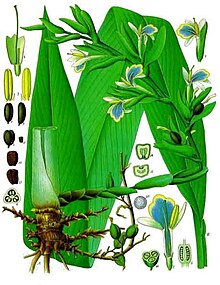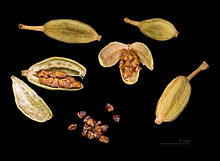Elettaria
| Elettaria | ||||||||||||
|---|---|---|---|---|---|---|---|---|---|---|---|---|

Green cardamom ( Elettaria cardamomum ) |
||||||||||||
| Systematics | ||||||||||||
|
||||||||||||
| Scientific name | ||||||||||||
| Elettaria | ||||||||||||
| Maton |
Elettaria is a genus of plants in the subfamily of the Alpinioideae withinthe ginger family (Zingiberaceae). This genus has been monotypical since 2018. Only the green cardamom ( Elettaria cardamomum ) is known as a herb and medicinal plant.
description



Vegetative characteristics
Elettaria species are small to large, perennial herbaceous plants . They form creeping rhizomes as persistence organs. Usually robust “pseudostems” are formed from mostly many leaves . The large leaves are divided into petioles and lanceolate leaf blades.
Generative characteristics
A sometimes creeping, usually short, leafless inflorescence stem, which is often completely underground, develops directly from the rhizome. In a terminal, elongated, branched inflorescence with small bracts, a flower stands above a tubular bract ; so there are several to many flowers in one inflorescence.
The hermaphrodite, zygomorphic flowers are threefold with double perianths , the flower colors white or from yellow to orange. The three sepals are fused Roehrig. The three petals are fused with corolla lobes that are at most half as long as the corolla tube. Only the middle stamen of the inner circle is fertile ; it has a short or no discernible stamen . The anthers have inconspicuous to no appendages. All other stamens have been converted to staminodes and at least one or three are missing. The two lateral staminodes of the outer circle are small, awl-shaped, or absent. The two lateral staminodes of the inner circle have grown together to form a so-called labellum ; it represents the most conspicuous part of the flower. The obovate labellum is about as long as the petals. Three carpels have grown together to form a three- chamber ovary.
The capsule fruits are spherical to ellipsoid. The seeds have an aril .
The number of chromosomes is 2n = 48 or 50.
Systematics and distribution
The main distribution area is Malesia . Eight species only occur in Borneo . One species is native to India . The best-known species ( Elettaria cardamomum ) originally only occurs in Sri Lanka , but is cultivated in many tropical countries and is considered an invasive plant in Tanzania, for example . Today, Guatemala is one of the largest green cardamom growing countries.
The genus Elettaria belongs to the tribe Alpinieae in the subfamily of the Alpinioideae within the family of the Zingiberaceae .
The genus Elettaria was established in 1811 by William George Maton in Transactions of the Linnean Society of London , 10, page 250. The type species is Elettaria cardamomum (L.) Maton . The generic name Elettaria is derived from the Tamil word "Elettari" for the seeds of Elettaria cardamomum .
The genus Elettaria contains seven to eleven species:
- Elettaria brachycalyx S.Sakai & Nagam. : The home is Sarawak .
- Green cardamom ( Elettaria cardamomum (L.) Maton , Syn .: Alpinia cardamomum (L.) Roxb. , Amomum cardamomum L. , Amomum ensal Raeusch. , Amomum racemosum Lam. , Amomum repens Sonn. , Amomum uncinatum Stokes , Cardamomum elletari Garsault , cardamomum malabaricum injection. , cardamomum minus (Gaertn.) Kuntze , cardamomum officinale Salisb. , cardamomum verum Oken , Elettaria cardamomum var. minus Watt , Elettaria cardamomum var. minuscula Burkill , Elettaria repens (Sonn.) Baill. , Matonia cardamomum (L .) Stephenson & JMChurchill , Zingiber minus Gaertn. ): The original homeland is southwest India.
- Elettaria ensal (Gaertn.) Abeyw. : The home is Sri Lanka.
- Elettaria kapitensis S.Sakai & Nagam. : The home is Sarawak.
- Elettaria linearicrista S. Sakai & Nagam. : The home is Borneo.
- Elettaria longipilosa S. Sakai & Nagam. : The home is Sarawak.
- Elettaria longituba (Ridl.) Holttum : The home is the Malay Peninsula and Sumatra .
- Elettaria multiflora (Ridl.) RMSm. : The home is Sumatra and Sarawak.
- Elettaria rubida R.M.Sm. : The home is Borneo.
- Elettaria stoloniflora (K.Schum.) S.Sakai & Nagam. : The home is Sarawak.
- Elettaria surculosa (K.Schum.) BLBurtt & RMSm. : The home is Sarawak.
swell
Recent literature on Elettaria s. st.
- H. de Boer, M. Newman, AD Poulsen, AJ Droop, T. Fér, LTT Hiên, K. Hlavatá, V. Lamxay, JE Richardson, K. Steffen, J. Leong-Škorničková: Convergent morphology in Alpinieae (Zingiberaceae) : Recircumscribing Amomum as a monophyletic genus. Taxon , Volume 67, Issue 1, 2018, pp. 6-36. doi : 10.12705 / 671.2
Historical sources on Elettaria s. l.
- Shoko Sakai, H. Nagamasu: Systematic studies of Bornean Zingiberaceae: II. Elettaria of Sarawak. In: Edinburgh-Journal of Botany , Volume 57, 2000, pp. 227-243. (Sections Description, Systematics and Distribution)
- The genus Elettaria at the National Museum of Natural History (NMNH) of the Smithsonian Institution . (Sections Description and Distribution)
- PN Ravindran, KJ Madhusoodanan: Cardamom: the genus Elettaria . CRC Press, 2002, ISBN 978-0-415-28493-6 , pp. 374 ( limited preview in Google Book search).
Individual evidence s. l.
- ↑ Rafaël Govaerts, 2001: World Checklist of Seed Plants Database in ACCESS EF , 1-50919. Rafaël Govaerts (Ed.): Elettaria. In: World Checklist of Selected Plant Families (WCSP) - The Board of Trustees of the Royal Botanic Gardens, Kew . Retrieved June 7, 2020.
- ↑ Elettaria in the Germplasm Resources Information Network (GRIN), USDA , ARS , National Genetic Resources Program. National Germplasm Resources Laboratory, Beltsville, Maryland. Retrieved March 23, 2018.